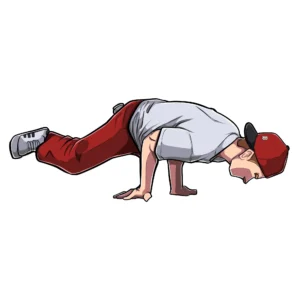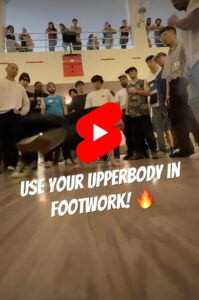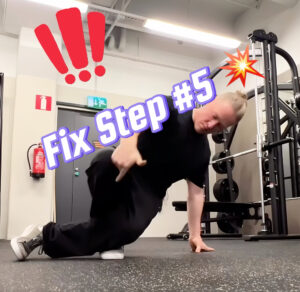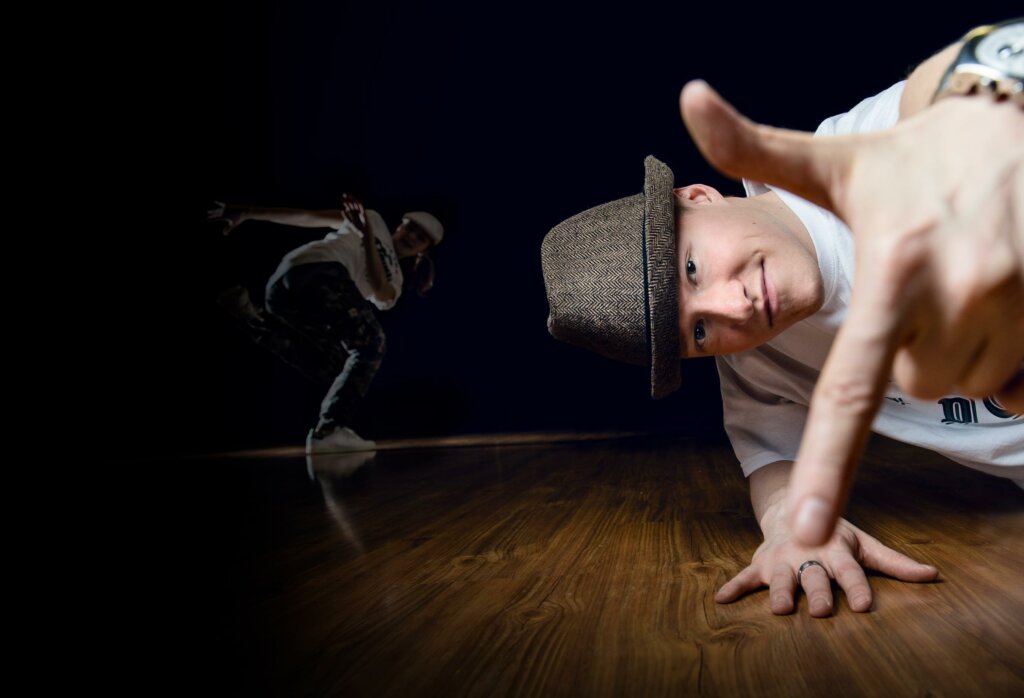Watching jackhammers in breaking is an easy way to wow any crowd. At first glance, this is a move that looks quite simply impossible to pull off, which is why so many novices classify them as one of the top 10 breakdance moves they want to learn.
Like so many moves, the jackhammer move is an illusion. Mere mortals believe it’s all about raw strength, but it’s all about balance and knowing where to shift your weight. If you’re wondering how to breakdance and want to add jackhammers to your jam, here’s what you need to know.
What are Jackhammers?
Jackhammers rely on a “stabbing” technique. As part of this move, breakers place their whole body weight onto their elbows. The elbows are then jammed into the stomach at 90 degrees, which is where the term “stabbing” comes from.
You’ll learn this as part of the perfect practice formula, but what is a jackhammer precisely? It’s a variation of the much-loved cricket move. The cricket is a type of float, which are moves derived from basic gymnastics.
Essentially, jackhammers, when learning how to breakdance, are no more than crickets performed with one hand. They’re typically faster than crickets, and the free hand is used in another position to demonstrate control with a single hand. One breaker notorious for performing this move is b-boy Pop from the Gamblerz crew from South Korea.
Due to the immense balance and control required to perform jackhammer breakdance moves, many of the top 10 b-boys have used them to compete for world records. As of this writing, b-boy RYUTA holds the record with 113 consecutive jackhammers
The History of the Jackhammers Move
Understanding the origins of this move begins by looking into the history of breakdance. Developed in the 1970s in South Bronx, New York, African-American and Latino youth developed breaking alongside the rise of hip-hop culture.The 1970s was where countless moves originated, including the perfect b-boy form, alongside floats. Floats come from basic gymnastics and involve placing a dancer’s bodyweight onto their elbows and into their lower abdomens.
With the float established, it didn’t take long for hand glides and crickets to appear. Naturally, this led to the move being taken to the next level, and that’s where jackhammers come from. It’s also important to mention that floats served as the gateway to the first power moves developed in the early 1980s.
Although it’s possible to point to iconic figures in hip-hop, including DJ Kool Herc and b-boy Crazy Legs, it’s unknown who performed the jackhammer for the first time. However, it’s likely it emerged quickly, with the dynamic b-boy style of the time resulting in young people constantly trying to outdo each other.
The complexity and artistry of the move have resulted in it sticking around and becoming a concrete part of breaking sets worldwide.
How to Do the Jackhammers Move for Beginners
Jackhammers may require strength, balance, and control, but the formula for mastering them remains the same despite how difficult they look. As with learning how to do a headspin or how to airflare, it’s a matter of knowing where to start and progressing slowly.
This is why taking courses and working with a great breaking teacher pays dividends. If you’re ready to get down with the jackhammer, here’s how to do it step-by-step.
Step One – Starting Position
Like other moves, how you start will determine whether you pull off the move successfully or not. Start in your b-boy stance and smoothly get into the push-up position.
The push-up position should include both hands on the ground in front of you shoulder-width apart with your legs extended. If done correctly, your body should form a completely straight line.
Spread your fingers wide apart to make it easier to balance and “grip” the floor.
Step Two – Float in the Air
The next step is actually to begin the float. Jackhammers breakdance moves require you to shift all your weight onto one side, your supporting hand.
In one fluid motion, shift your weight onto your dominant hand and lift your legs off the ground. Beginners may find it easier to use both hands before removing their non-supporting hands. Remember, it’s the supporting hand that’s used for the jackhammer.
Your elbow should be at a 90-degree angle and stuck into your stomach. As with any other type of balance, the closer you keep everything tucked into your body, the easier it is.
Your non-supporting hand may be used for style or to make it easier to balance yourself. Some breakers prefer to twist their non-supporting hands around their backs to express skill and style.
Step Three – Add Motion to Create the Jackhammer
Balancing, on the one hand, can serve as a freeze variation, but the beauty in jackhammers is the motion that comes with it. Note that you should already be able to perform a cricket, which uses two hands instead of one.
If so, you likely already know that the motion comes from pushing your legs and twisting your supporting hand to create motion. This circular leg motion above the ground involves subtle kicks with your hand following.
Look to complete a full 360-revolution, and you’ve completed your very first jackhammer. Once you’ve become confident in jackhammers, it’s time to increase the difficulty gradually. Focus on controlling your speed and increasing the height of your leg motion.
Finally, consider incorporating the jackhammers move into your set, including transitioning into and out of it.
Conclusion
Mastering jackhammers breakdance moves is an illustration of progression as a breaker. But just like other moves, the quickest way to learn is not through trial and error but with an experienced breaker on your side.
At the B-Boy & B-Girl Dojo, we feature courses on every aspect of breaking, from footwork essentials to the art of power flow. If you’re looking for the online school to take your breaking skills to the next level, sign up for one of our courses today and get ready to learn from the best.









